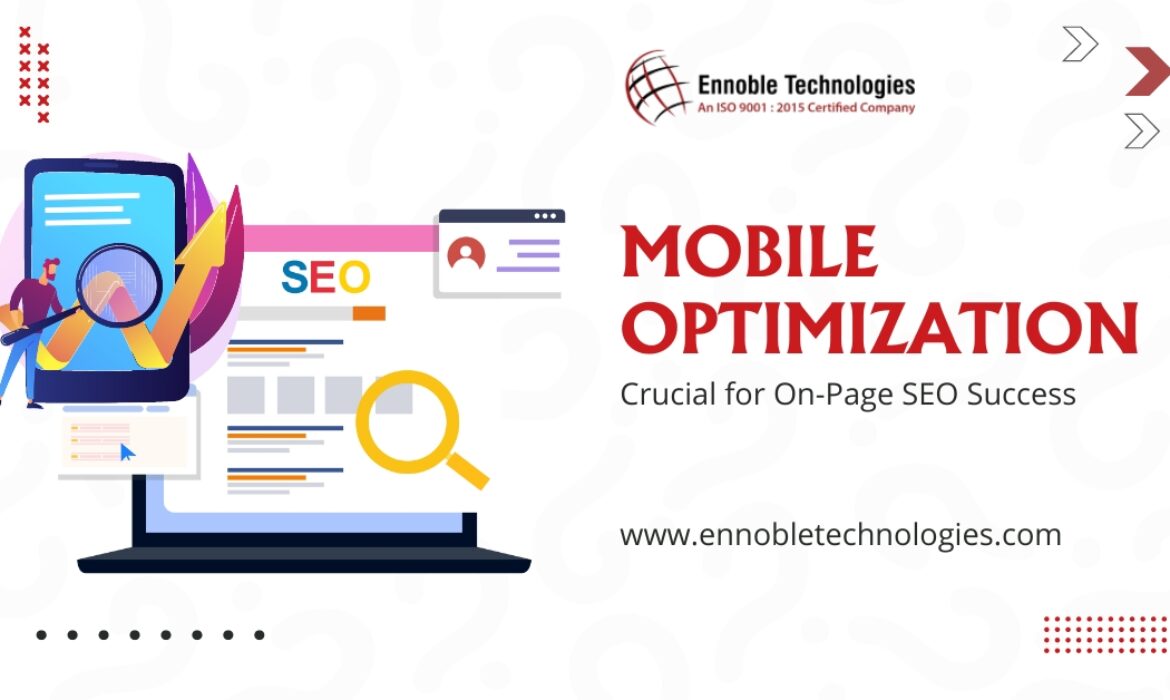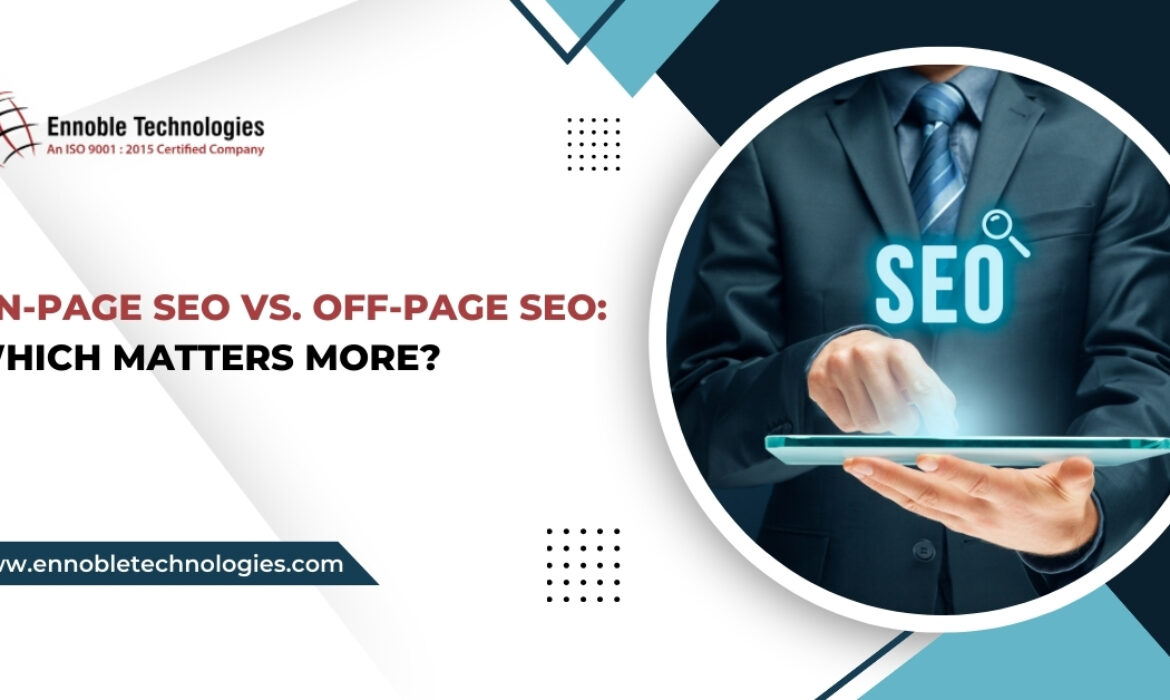Mobile Optimization: Crucial for On-Page SEO Success
In the fast-evolving landscape of digital marketing, staying ahead of the curve is not just a choice; it’s a necessity. As the majority of online users transition to mobile devices, the significance of mobile optimization cannot be overstated. This article delves into the intricate realm of Mobile Optimization and its pivotal role in achieving on-page SEO success.
I. Introduction
A. Definition of Mobile Optimization
Mobile Optimization refers to the process of ensuring that a website functions seamlessly and offers an optimal user experience on mobile devices. This involves responsive design, efficient loading times, and content adaptation to cater to the diverse array of mobile screens.
B. Significance of Mobile Optimization in On-Page SEO
The relationship between Mobile Optimization and on-page SEO is symbiotic. Google’s algorithms increasingly prioritize mobile-friendly websites, making it imperative for businesses and website owners to prioritize mobile optimization efforts.
C. Evolution of Mobile Usage and Its Impact on SEO
The surge in mobile device usage has transformed the digital landscape. From search behaviors to user expectations, understanding the evolution of mobile usage is crucial for devising effective mobile optimization strategies.
II. Importance of Mobile-Friendly Websites
A. User Experience (UX) and Mobile Responsiveness
1. Role of Responsive Design
Responsive design ensures that a website adapts to various screen sizes, providing a consistent and enjoyable user experience across devices. Its role in mobile optimization is foundational.
2. Impact on Bounce Rates
A mobile-friendly website contributes to lower bounce rates, indicating that users find the content engaging and accessible. High bounce rates may adversely affect search rankings.
B. Google’s Mobile-First Indexing
1. Understanding Mobile-First Index
Google’s Mobile-First Index prioritizes the mobile version of a website for indexing and ranking. Websites not optimized for mobile may experience a decline in search visibility.
2. How it Influences Search Rankings
Mobile-First Indexing directly impacts search rankings. Websites optimized for mobile devices are likely to rank higher, reflecting Google’s commitment to delivering mobile-friendly search results.
III. Key Elements of Mobile Optimization
A. Page Speed Optimization
1. Impact on Mobile Users
Mobile users are inherently impatient. Slow-loading pages can result in high bounce rates and diminished user satisfaction. Page speed optimization directly addresses these concerns.
2. Tools for Assessing and Improving Page Speed
Various tools, such as Google PageSpeed Insights, help assess and enhance page speed. These tools provide actionable insights to streamline website performance.
B. Mobile-Friendly Content
1. Crafting Engaging and Readable Content
Content tailored for mobile users prioritizes concise and engaging information. Short paragraphs, bullet points, and clear headings enhance readability on smaller screens.
2. The Role of Headings and Subheadings
Structuring content with well-defined headings and subheadings not only aids readability but also assists search engines in understanding the context of the content.
C. Mobile SEO Best Practices
1. Meta Tags and Descriptions
Optimizing meta tags and descriptions for mobile devices ensures that search results display relevant and concise information, encouraging users to click through.
2. Structured Data Markup for Mobile
Implementing structured data markup helps search engines comprehend the content’s structure, leading to enhanced visibility and rich snippets in mobile search results.

IV. Responsive Design vs. Mobile Apps
A. Advantages and Disadvantages of Responsive Design
1. Flexibility and Consistency
Responsive design offers flexibility by adapting to different devices, maintaining consistency in branding and user experience. However, potential drawbacks need careful consideration.
2. Mobile Apps and SEO
While mobile apps provide a dedicated user experience, optimizing them for search engines presents challenges. Balancing the advantages and disadvantages is crucial for mobile SEO success.
B. Mobile Apps and SEO
1. Enhanced User Experience
Mobile apps can deliver a tailored and immersive user experience. Capitalizing on app-specific features contributes to increased user engagement.
2. Challenges in App-Optimized SEO
Optimizing mobile apps for search engines requires unique strategies. Overcoming challenges related to app indexing and content visibility is paramount.
V. Technical Aspects of Mobile Optimization
A. Mobile Crawlability
1. Ensuring Accessibility for Search Engines
Search engines must efficiently crawl and index mobile content. Ensuring mobile crawlability involves eliminating obstacles that hinder search engine access.
2. Common Mobile Crawl Issues
Identifying and resolving common mobile crawl issues, such as blocked resources or faulty redirects, is essential for maintaining a robust mobile presence in search results.
B. Mobile Sitemaps
1. Importance in Indexing
A well-structured mobile sitemap aids search engines in understanding the website’s mobile content, facilitating efficient indexing and retrieval.
2. Creating an Effective Mobile Sitemap
Crafting a mobile sitemap involves delineating the structure of mobile pages, URLs, and their interrelationships. This ensures comprehensive coverage in search engine indexes.
VI. Optimizing Images and Multimedia for Mobile
A. Importance of Compressed Images
1. Impact on Loading Speed
Large image files can significantly slow down page loading times. Compressing images without compromising quality is pivotal for mobile optimization.
2. Tools for Image Compression
Utilizing image compression tools, such as TinyPNG or ImageOptim, assists in reducing file sizes while maintaining visual integrity.
B. Video Optimization for Mobile
1. Embedding Mobile-Friendly Videos
Mobile optimization extends to multimedia. Embedding videos optimized for mobile devices enhances user engagement and page performance.
2. Improving Video Loading Times
Optimizing video loading times, possibly through adaptive streaming and efficient encoding, contributes to a seamless mobile user experience.

VII. User Engagement Metrics for Mobile
A. Dwell Time and Its Significance
1. Measuring User Engagement
Dwell time, the duration a user spends on a page, is a critical metric. Longer dwell times indicate user satisfaction and relevance, positively impacting SEO.
2. Strategies for Increasing Dwell Time
Compelling content, intuitive navigation, and relevant internal links are strategies to increase dwell time, signaling to search engines the value of the content.
B. Mobile-Friendly Call-to-Actions
1. Designing Actionable CTAs
Mobile-friendly call-to-actions should be visually appealing and easy to interact with on smaller screens. They play a pivotal role in driving desired user actions.
2. Impact on Conversion Rates
Efficiently designed mobile CTAs contribute to improved conversion rates, translating user engagement into desired outcomes, such as sign-ups or purchases.
VIII. Mobile SEO Analytics
A. Utilizing Mobile Analytics Tools
1. Google Analytics for Mobile
Google Analytics provides insights into mobile user behavior, allowing webmasters to track performance, identify trends, and make data-driven decisions.
2. Interpreting Mobile-Specific Metrics
Metrics like mobile bounce rates, device-specific traffic, and conversion rates offer valuable insights into the effectiveness of mobile optimization strategies.
B. A/B Testing for Mobile Optimization
1. Experimenting with Mobile Variations
A/B testing involves experimenting with different elements on mobile pages to identify optimal configurations. This iterative process fine-tunes mobile optimization strategies.
2. Analyzing Test Results
Thorough analysis of A/B test results informs ongoing optimization efforts, ensuring that changes positively impact user experience and SEO performance.
IX. Challenges and Solutions in Mobile Optimization
A. Device Fragmentation
1. Addressing Compatibility Issues
The diverse landscape of mobile devices poses challenges in ensuring compatibility. Strategies like responsive design and testing on various devices are crucial.
2. Progressive Enhancement vs. Graceful Degradation
Choosing between progressive enhancement and graceful degradation strategies depends on the target audience and balancing advanced features with broad compatibility.
B. Future-Proofing Mobile SEO
1. Adapting to Technological Changes
Staying ahead involves anticipating and adapting to technological shifts, such as changes in mobile devices, screen sizes, and user behaviors.
2. Staying Ahead of Mobile Algorithm Updates
Regularly monitoring and adapting to mobile algorithm updates, including Google’s, ensures that a website remains optimized and visible in search results.

X. Case Studies on Successful Mobile Optimization
A. Examining Noteworthy Examples
1. Before and After Mobile Optimization
Analyzing case studies showcasing websites before and after mobile optimization highlights the tangible impact on organic traffic and user engagement.
2. Impact on Organic Traffic and Conversions
Successful mobile optimization correlates with increased organic traffic, improved search rankings, and a positive impact on conversion rates.
XI. Mobile Optimization and Local SEO
A. The Intersection of Mobile and Local Searches
1. Local SEO Strategies for Mobile
Tailoring mobile optimization efforts to local SEO considerations enhances visibility in location-based searches, a critical aspect for businesses with a physical presence.
2. Importance of Mobile Maps and Location-Based Information
Integrating mobile maps and providing accurate location-based information ensures that businesses are easily discoverable in mobile search results.
XII. Mobile Security Concerns and SEO
A. Ensuring Secure Mobile Transactions
SSL Certificates and Mobile SEO
- Highlighting the role of SSL certificates in securing mobile transactions and its positive impact on SEO.
Building Trust through Mobile Security
- Discussing the importance of establishing trust with users through robust mobile security measures.
XIII. Voice Search and Mobile Optimization
A. The Rise of Voice Searches
Optimizing for Voice-Based Queries
- Exploring strategies to optimize content for voice search, considering the increasing prevalence of voice-activated devices.
Impact on Mobile SEO Strategies
- Discussing how voice search trends influence the evolution of mobile SEO strategies.
XIV. Mobile Optimization for E-Commerce Websites
A. Unique Challenges in Mobile E-Commerce
Mobile Shopping Experience
- Addressing challenges specific to mobile shopping experiences and providing solutions for enhanced user engagement.
Mobile Checkout Optimization
- Offering tips for optimizing the mobile checkout process to reduce friction and increase conversions.
XV. Social Media Integration and Mobile SEO
A. Mobile-Friendly Social Sharing
Importance for SEO
- Emphasizing the impact of mobile-friendly social sharing on SEO and social media visibility.
Integrating Social Media Buttons Responsively
- Providing guidelines for seamlessly integrating social media buttons into mobile interfaces.

XVI. The Role of Mobile-Friendly AMP Pages
A. Accelerated Mobile Pages (AMP)
Benefits for SEO
- Explaining the advantages of AMP in terms of improved page speed and its positive influence on SEO rankings.
Implementing AMP for Improved Page Speed
- Offering practical insights into implementing AMP for enhanced mobile page loading speed.
XVII. International SEO and Mobile Optimization
A. Mobile SEO for Multilingual Websites
Hreflang Tags and Mobile Versions
- Explaining the use of hreflang tags to optimize mobile versions of multilingual websites for international SEO.
Addressing International Mobile SEO Challenges
- Discussing common challenges in international mobile SEO and providing solutions.
XVIII. Mobile SEO Checklist
A. Comprehensive Checklist for Mobile Optimization
Technical Checks
- Listing essential technical checks to ensure a well-optimized mobile website.
Content and Design Checks
- Highlighting key elements to review regarding mobile content and design.
XIX. Keeping Abreast of Mobile SEO Trends
A. Continuous Learning and Adaptation
Staying Informed about Industry Changes
- Recommending resources and strategies for staying updated on evolving mobile SEO trends.
Attending Mobile SEO Conferences and Webinars
- Encouraging professionals to participate in events for networking and learning from industry experts.
XX. Conclusion
A. Recap of Key Mobile Optimization Takeaways
Summarizing the key points discussed throughout the blog post, emphasizing their significance in achieving successful mobile optimization.
B. Emphasizing the Ongoing Importance of Mobile SEO
Concluding with a reminder of the perpetual importance of mobile optimization in the ever-changing landscape of online search and user behavior.
Also Read: On-Page SEO vs. Off-Page SEO: Which Matters More? – Ennoble Technologies
On-Page SEO vs. Off-Page SEO: Which Matters More?
SEO, a crucial aspect of online visibility, comes in various forms. In the realm of Search Engine Optimization, the debate often centers around On-Page SEO and Off-Page SEO. In this comprehensive guide, we delve into the nuances of both strategies, exploring their strengths, and weaknesses, and ultimately answering the question: Which Matters More?
Introduction
SEO is the backbone of digital success, and understanding its intricacies is paramount for any online venture. The landscape is dominated by two main approaches: On-Page SEO and Off-Page SEO. Each plays a distinct role in enhancing a website’s visibility on search engines, but the question persists – which one holds more weight?
Unveiling the Power of On-Page SEO
Crafting Content that Commands Attention
On-Page SEO is the bedrock of a well-optimized website. At its core, it revolves around optimizing individual web pages to rank higher and earn organic traffic. The linchpin of On-Page SEO is undoubtedly content.
When we talk about content optimization, it’s not just about integrating keywords seamlessly but creating a symphony of words that captivates and informs. High-quality, relevant, and engaging content not only satisfies search engine algorithms but also keeps your audience hooked.
The Alchemy of Keywords
In the world of On-Page SEO, keywords reign supreme. Thorough keyword research is the secret sauce that propels your content to the top of search engine results. From long-tail keywords to semantic search, understanding the nuances of what your audience is searching for is key to unlocking the full potential of On-Page SEO.
Strategically placing keywords in titles, meta descriptions, and throughout the content enhances the discoverability of your page, signaling to search engines that your content is not just relevant but authoritative.
Technical Excellence: The Backbone of On-Page Optimization
Beyond captivating content and strategic keyword placement, the technical aspects of your website cannot be overlooked. From meta tags and image alt attributes to mobile responsiveness and site speed, every technical facet contributes to the holistic optimization of your web pages.
Ensuring a seamless user experience and a technically sound website not only pleases search engines but also enhances user satisfaction, a factor increasingly crucial in the ever-evolving landscape of SEO.

Importance of On-Page SEO
The significance of On-Page SEO cannot be overstated. It is the first impression your website makes on search engines, influencing ranking and user engagement. Dive deep into this section to uncover why On-Page SEO is the cornerstone of a robust online presence.
Key On-Page SEO Elements
Explore the key elements that constitute effective On-Page SEO. From meta descriptions to header tags, understanding and implementing these elements is crucial for optimizing your web pages for search engines.
Advanced On-Page Strategies
Beyond the basics, there are advanced strategies that can propel your On-Page SEO efforts to new heights. Uncover these techniques and stay ahead in the competitive digital landscape.
Decoding the Impact of Off-Page SEO
Backlinks: Building Bridges to Authority
Off-Page SEO, on the other hand, extends its influence beyond the boundaries of your website. It is the art of building a digital reputation through external factors, with backlinks taking center stage.
Acquiring high-quality backlinks from authoritative sources is akin to building bridges to your website. Each link acts as a vote of confidence, signaling to search engines that your content is deemed valuable by others in the digital ecosystem. The more credible the source, the more significant the impact on your website’s authority.
Social Signals: A Symphony of Validation
In the age of social media dominance, social signals have emerged as influential players in Off-Page SEO. The buzz, shares, and mentions across various social platforms contribute to the validation of your content’s relevance and appeal.
Crafting shareable content and actively participating in social conversations not only amplifies your brand presence but also sends positive signals to search engines about the societal value of your content.
Off-Page SEO Defined
Contrary to On-Page SEO, Off-Page SEO involves external factors that influence your website’s ranking. This section breaks down the components of Off-Page SEO and its role in the grand scheme of things.
Building Backlinks
Backlinks are the currency of Off-Page SEO. Learn how to build high-quality backlinks that not only improve your website’s authority but also contribute to higher search engine rankings.

Social Signals and Off-Page SEO
In an era dominated by social media, understanding how social signals impact Off-Page SEO is crucial. Discover the synergy between your social media presence and search engine rankings.
Content Marketing in Off-Page SEO
Content remains king, even in the realm of Off-Page SEO. Explore how creating valuable content can attract external links, elevating your website’s authority in the digital space.
Comparing On-Page and Off-Page Strategies
A side-by-side analysis is essential to determine the strengths and weaknesses of On-Page and Off-Page SEO. This section provides a comprehensive comparison to help you make informed decisions.
The Synergy of On-Page and Off-Page SEO
While the debate often revolves around choosing one over the other, the true power lies in their synergy. Discover how combining On-Page and Off-Page SEO strategies can create a holistic and effective approach to online visibility.
Common Misconceptions
In the ever-evolving world of SEO, myths and misconceptions abound. Separate fact from fiction as we debunk common myths surrounding both On-Page and Off-Page SEO strategies.
SEO Case Studies
Real-world examples speak volumes. Explore case studies highlighting successful On-Page and Off-Page SEO strategies, providing insights into what works in different scenarios.
Future Trends in SEO
The digital landscape is dynamic, and SEO is no exception. Gain a glimpse into the future as we predict upcoming trends and innovations that will shape the SEO landscape.
Conclusion
In the tug-of-war between On-Page and Off-Page SEO, the answer to which matters more lies in their harmonious integration. Both are indispensable, and a balanced approach ensures sustainable online success. As you navigate the intricate world of SEO, Navigating the dynamic landscape of SEO requires a holistic understanding of On-Page and Off-Page strategies. As you embark on your SEO journey, remember, it’s not about choosing one over the other; it’s about embracing the power of both.
FAQs
Q: Is On-Page SEO more important than Off-Page SEO?
A: On-Page and Off-Page SEO are symbiotic. While On-Page SEO lays the foundation, Off-Page SEO builds the structure. Both are essential for holistic search engine optimization.
Q: How do backlinks affect Off-Page SEO?
A: Backlinks act as a vote of confidence for your website. Quality backlinks enhance your site’s authority and positively impact Off-Page SEO, contributing to higher search engine rankings.
Q: Can social media really influence Off-Page SEO?
A: Absolutely. Social signals, such as likes and shares, indicate content relevance. A robust social media presence correlates with improved Off-Page SEO, driving organic traffic.
Q: What role does content play in Off-Page SEO?
A: Content is the linchpin. Creating valuable, shareable content attracts external links, a fundamental aspect of Off-Page SEO. Quality content contributes significantly to online visibility.
Q: Are there SEO strategies that combine On-Page and Off-Page techniques?
A: Certainly. The most effective SEO strategies embrace both On-Page and Off-Page techniques. The synergy between these approaches amplifies the overall impact on search engine rankings.
Q: Are SEO myths affecting my digital strategy?
A: It’s common to encounter myths. However, staying informed through credible sources and ongoing learning is crucial to separating fact from fiction in the ever-evolving field of SEO.
Also Read: Mastering On-Page SEO: Practical Tips & Tricks – Ennoble Technologies





